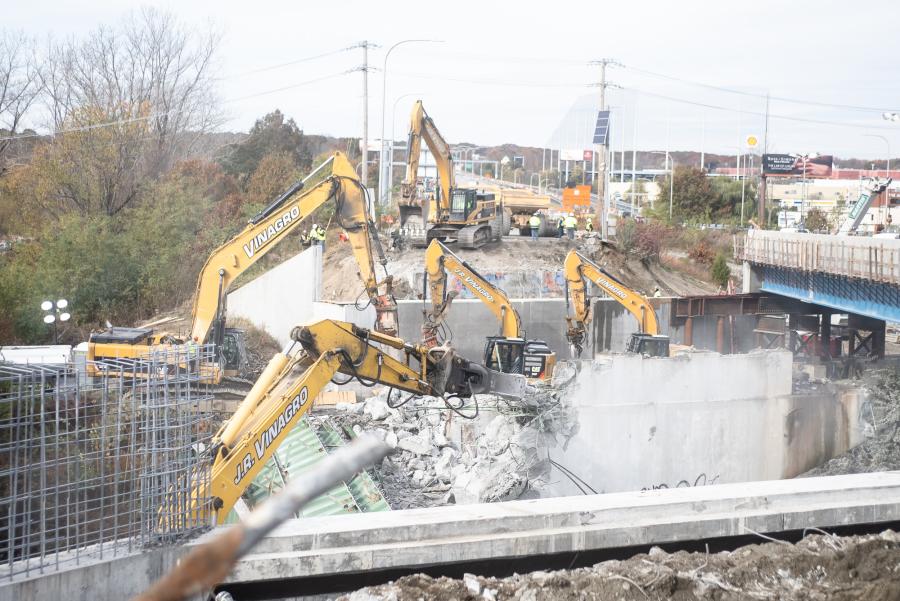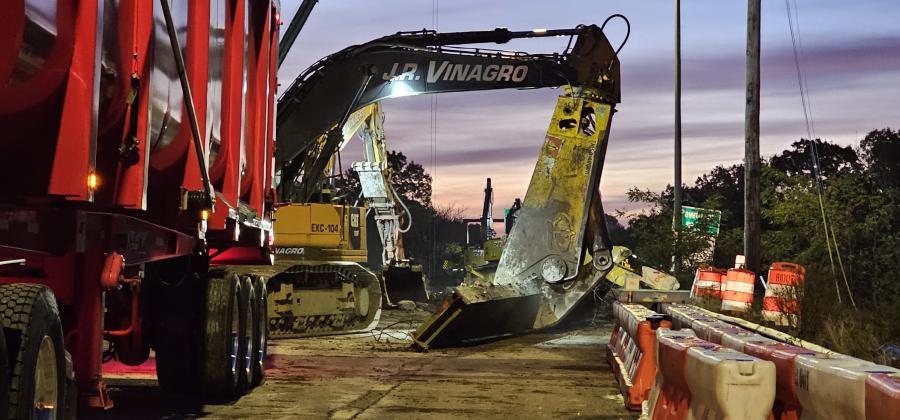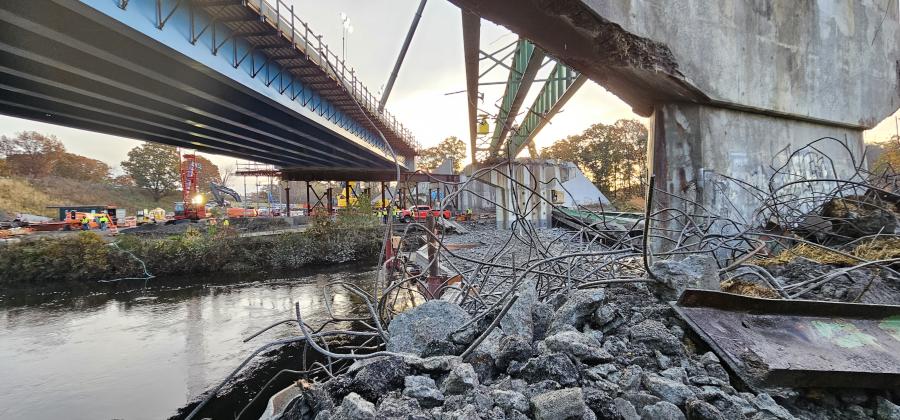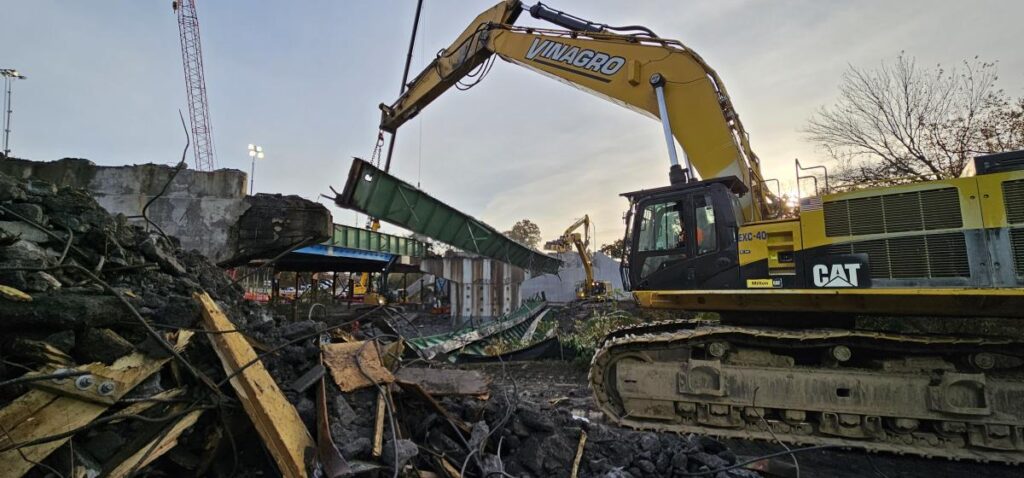Photo courtesy of J.R. Vinagro Corp.
The first stage of work was demolition of the R.I. 37 bridge’s concrete deck and barrier; structural steel beams and concrete abutments; and pier over a single weekend.
As part of a major effort to improve Rhode Island Highway 37 between the cities of Cranston and Warwick, the state’s Department of Transportation (RIDOT) is steering two separate phases of work on the critical east-west freeway.
The overall project has been designed to rehabilitate or replace 22 bridges and make safety and congestion improvements along the corridor.

Photo courtesy of J.R. Vinagro Corp.
The state did not have to look far to secure the services of one of the Northeast’s top contractors, J.R. Vinagro Corp. (JRV) in Johnston, R.I., to replace a key bridge that spans the Pawtuxet River, part of RIDOT’s first phase of the work.
Since its formation in 1998, J.R. Vinagro has been known primarily as a demolition, recycling, asbestos abatement and site development services company.
But, in 2023, the transportation department contracted with JRV to first demolish, then replace the severely deficient highway structure carrying R.I. 37 Eastbound across the river using the Accelerated Bridge Construction (ABC) method.
The bridge’s replacement became the first such project ever performed by JRV and by all accounts, it was a rousing achievement for the company.
RIDOT had earlier deemed the Pawtuxet River bridge’s structural steel and concrete substructure to be in critical condition.
According to Trevin Alpaio, JRV’s project manager at the site, the company’s strategy in replacing the bridge only began after “months of planning, allocating resources like labor and equipment to every step of the project, and preparing an hour-by-hour schedule in order to accomplish our goal.”
“Once work commenced, it was important to track our productivity to maintain the schedule and to ensure the quality and accuracy of work,” he added. “Preparing resources in advance of each task was critical. We also made sure that each incoming labor shift overlapped with the last so that there was no lag in production or information turnover.”
Complete Demolition Within 18 Hours
The first stage of work was demolition of the R.I. 37 bridge’s concrete deck and barrier, structural steel beams and concrete abutments and pier over a single weekend.
JRV brought 20 crew members and several pieces of equipment to the site, Alpaio noted, including six mid-size excavators — among them Cat 335s and John Deere 345s — to remove concrete from the bridge deck.

Photo courtesy of J.R. Vinagro Corp.
“We then moved to the steel beam removal with the help of two of our largest demolition machines, the Cat 374 and Cat 390 excavators, along with a big Komatsu 490 excavator and several mid-size machines,” he said. “This equipment saved us precious time by eliminating the need for crane setup and breakdown.”
In addition, Alpaio said the removal of concrete substructure was accomplished with four mid-size excavators, large front-end loaders, including a Cat 980 and a pair of Volvo articulating rear-end dump trucks.
The relatively small demolition team finished their work in only about 18 hours, he added, despite the “massive hurdle” of capturing debris before it fell into the river.
Crews Meet All Challenges
To complete the bridge replacement on an accelerated schedule, the new superstructure needed to be built adjacent to the existing span on temporary abutments. That install was set to take place over a period of 60 hours on one weekend in late October.
Once demolition of the old abutments was completed, JRV’s crews could begin to backfill the new concrete abutments and slide the new bridge into place.
“The design incorporated precast concrete bridge elements, which were installed at the approaches of the new structure,” Alpaio said. “Final backfills of the roadway and wingwall slopes was followed by paving of the bridge deck and highway.”

Photo courtesy of J.R. Vinagro Corp.
With the temporary substructure complete, steel beam erection began in late August.
“The build back was accomplished with the help of 30-40 operators, laborers and carpenters as well as more excavators, loaders, bulldozers and dump trucks,” he said. “We were often running up to 10 machines at one time. We also utilized two 100-ton cranes in order to set precast concrete bridge elements on the prepared subgrade.”
The obvious schedule restrictions and sheer volume of material being handled also proved challenging for J.R. Vinagro at the R.I. 37 Eastbound bridge site, according to Alpaio, in addition to the discovery of PCBs within the old bridge barrier, which required the hazardous material to be separated from the rest of the concrete elements during demolition.
In the end, the construction firm considers its first bridge build to be a tremendous success, he said.
“This was one of the first bridge slides in the state of Rhode Island and I believe the largest to date,” Alpaio said. “JRV took on this challenge and was able to remove the deficient highway bridge and replace it with a new span with traffic back traveling over it safely within a tight timeframe.” CEG
Read the full article here











